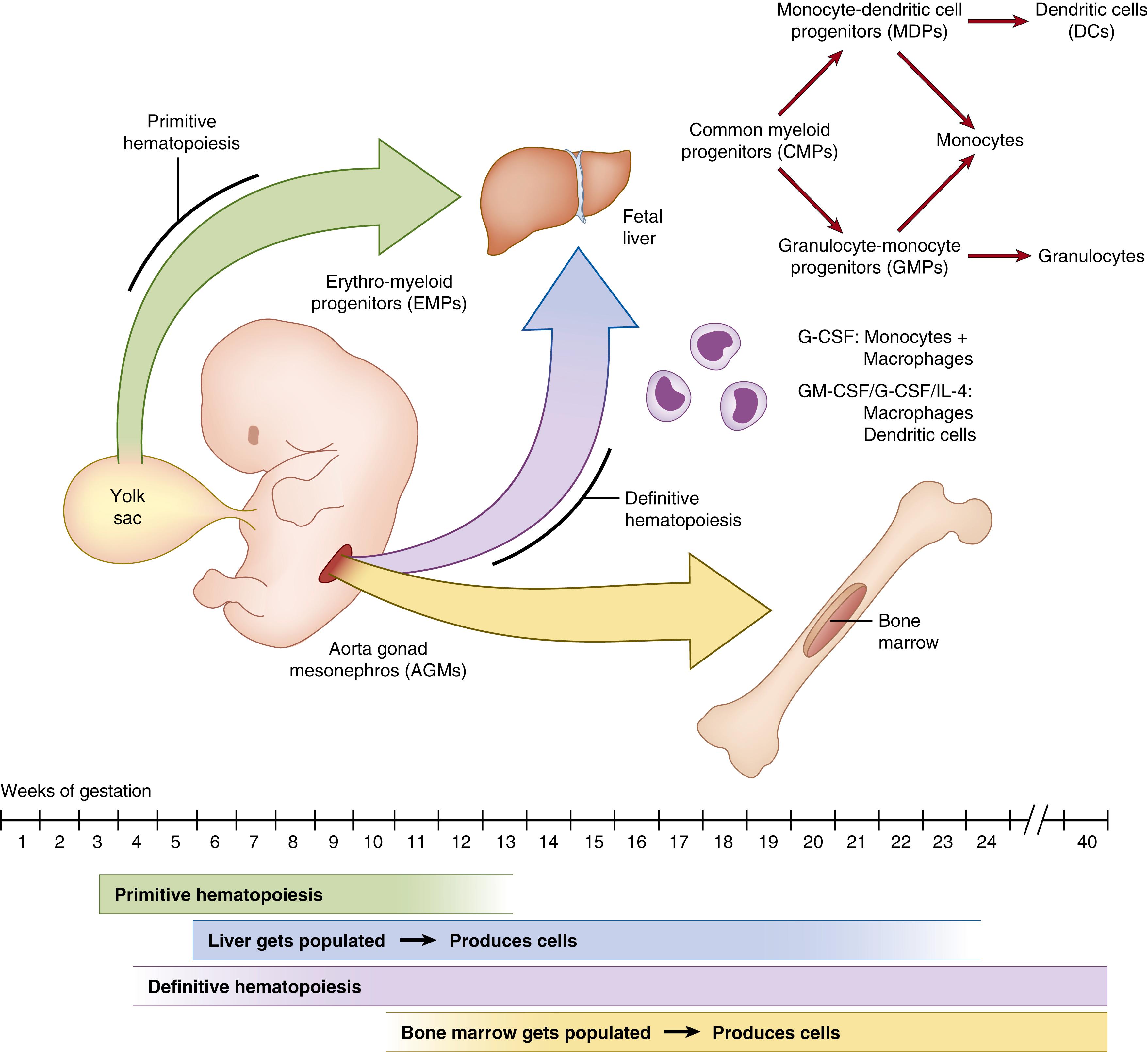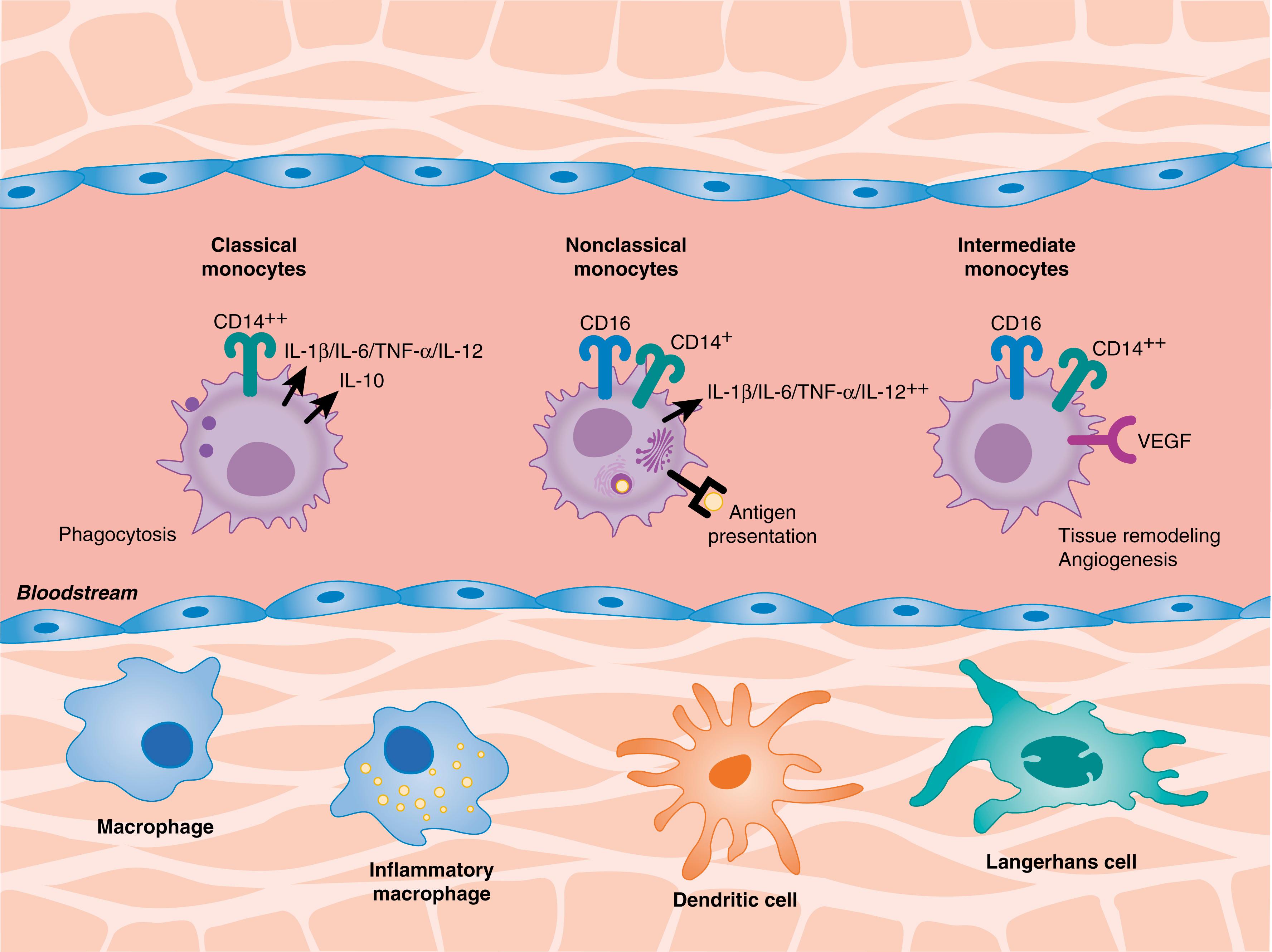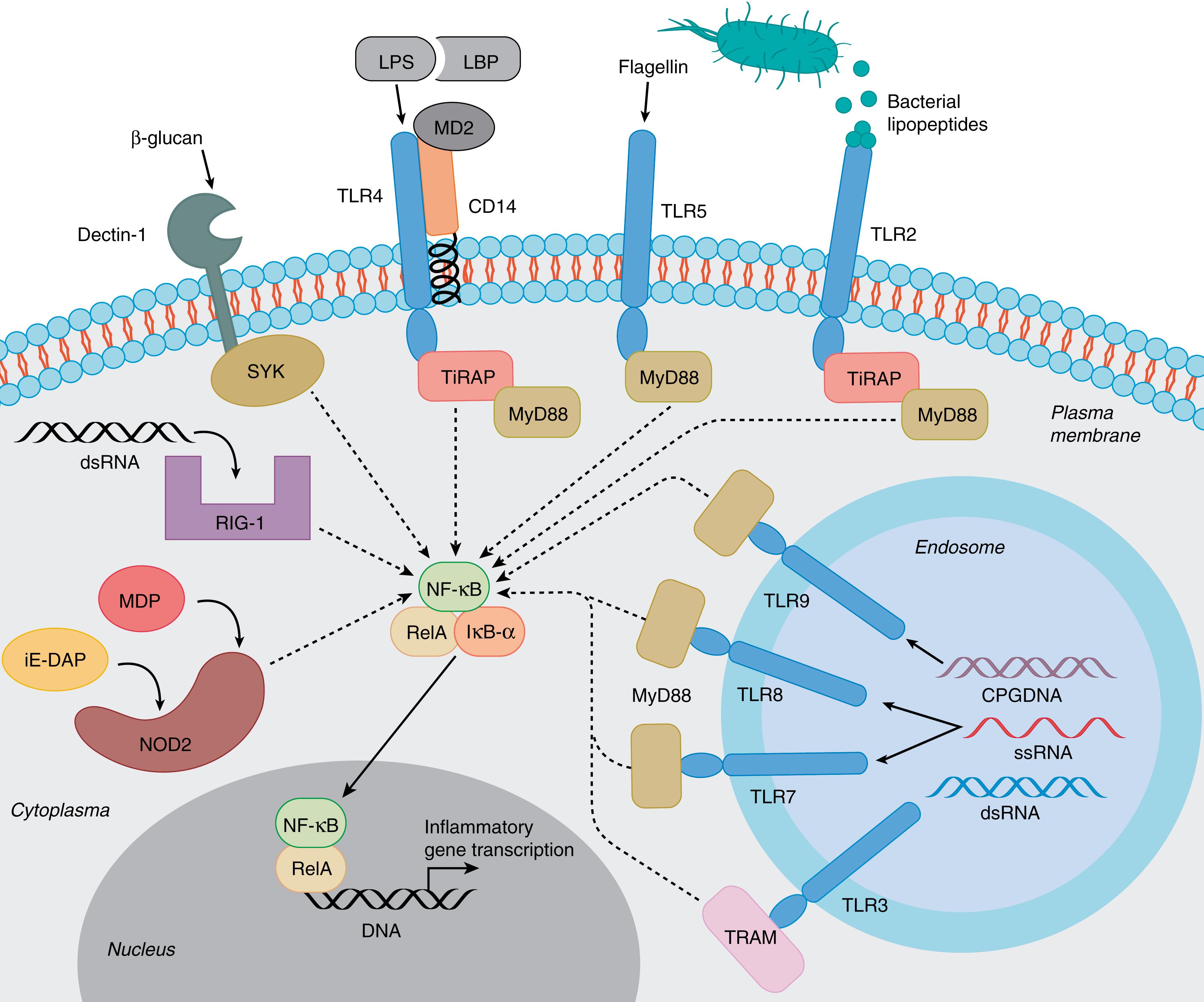Physical Address
304 North Cardinal St.
Dorchester Center, MA 02124
The mononuclear phagocyte system (MPS) refers to a network of cells that share the ability to engulf (i.e., internalize) and digest large particles such as whole microbes (e.g., bacteria, fungi, and viruses) or dying cells, but also tumor cells and toxic metabolic products. Mononuclear cells have a single, round nucleus. Neutrophils and other granulocytes also share phagocytic functions, but they are morphologically distinct, polynuclear, and have historically been excluded from the MPS. Neutrophils are covered in Chapter 119 .
Mononuclear phagocytes are located throughout different organs and tissues, in large numbers in the spleen, but also in organs such as the lungs, brain, liver, peritoneal cavity, and placenta, as well as the connective tissues. They are highly evolutionarily conserved in multicellular animals and plants and are a fundamental component of cellular immune defenses. In addition to their phagocytic capability, these cells can sense and migrate toward gradients of microbial products, secrete chemokine and cytokine mediators resulting in the migration and activation of other leukocytes, and present antigens to the adaptive immune system. They also accomplish other important homeostatic functions related to tissue repair, remodeling, angiogenesis, and neural networking during embryonic, fetal, and postnatal development.
The innate immune system is the first line of defense against microbes, whereas the adaptive immune system is most typically known for its capacity to develop immunologic memory upon pathogen encounters. Invertebrates and plants do not possess a traditional adaptive immune system. In vertebrates, mononuclear phagocytes are also endowed with functions related to the presence of an adaptive immune system, including phagocytosis of pathogens that have been marked via antibody opsonization and the production of specific T and B lymphocyte differentiation cytokines.
The MPS is composed of monocytes, macrophages, and dendritic cells (DCs). Monocytes predominate in blood, whereas macrophages and DCs reside in tissues. DCs are generally much less abundant compared with monocytes. They are the most efficient of the antigen-presenting cells. Thus they usually migrate into lymph nodes after sensing pathogens to present a fragment of this pathogen to T and B lymphocytes.
Mononuclear phagocytes are generated through a process called myelopoiesis . They arise in early embryogenesis, from at least two distinct hematopoietic waves: (1) a primitive wave that begins during the third week of gestation in the yolk sac (also called umbilical vesicle ), until gestational week 10 to 12 in humans ; this wave gives rise to red blood cells and embryonic macrophages , and (2) a definitive wave that begins during the fourth week of gestation and gives rise to all hematopoietic cell types, continuing into postnatal life. During primitive hematopoiesis, erythromyeloid progenitors (EMPs) emerge, to produce blood islands and establish a primitive circulation ( Fig. 118.1 ), and to produce embryonic macrophages that migrate into peripheral tissues such as the central nervous system (CNS). Embryonic macrophages retain a long-term capacity for self-renewal and cell survival, likely for years. Following the establishment of the blood circulation, primitive yolk sac–derived EMPs start seeding the fetal liver and spleen around the fifth week of gestation. In the second, definitive wave of hematopoiesis, lymphomyeloid progenitors (LMPs) migrate from the yolk sac to the liver (also called transient definitive wave). Pluripotent CD34-expressing hematopoietic stem cells (HSCs) that can give rise to all blood cells autonomously also begin to emerge around the fourth week of gestation in humans, in a region called the aortogonad mesonephros (AGM) situated in the endothelium of the dorsal aorta. Until approximately 22 weeks of gestation, the fetal liver and spleen remain the dominant sources of hematopoiesis. At approximately 8 to 10 weeks of gestation, HSCs start populating the bone marrow. During the third trimester of gestation the bone marrow becomes the main source of hematopoietic cells, continuing into postnatal life, and as hematopoiesis in the fetal liver gradually wanes.

Differentiation of progenitor cells into monocytes, macrophages, and DCs is guided by a highly coordinated epigenetic program involving chemical modifications of deoxyribonucleic acid (DNA), and reconfiguration of the chromatin and the structure of histones. Monocytes, macrophages, and DCs originate from common myeloid progenitors (CMPs). CMPs give rise to two main progenitor lineages: granulocyte-monocyte progenitors (GMPs), which give rise to granulocytes and monocytes, and monocyte-DC progenitors (MDPs), which give rise to another common DC progenitor (CDP, for DCs), but also to monocytes (see Fig. 118.1 ).
Monocytes are most abundant in blood, whereas macrophages are found in tissues. Once blood monocytes reach the tissues, they rapidly differentiate into macrophages, and monocyte-derived DCs (MoDCs) under certain inflammatory conditions. , In humans, development and differentiation of monocytes and macrophages from progenitors depend on the macrophage colony-stimulating factor (M-CSF, also known as CSF-1 ). Its receptor counterpart, the M-CSF receptor (MCSFR), is expressed on all three cell types of the MPS, as well as their precursors. M-CSF is part of a family that also includes granulocyte-macrophage colony-stimulating factor (GM-CSF) and interleukin (IL)-3. GM-CSF, granulocyte colony-stimulating factor (G-CSF), IL-4, and FMS-related tyrosine kinase 3 ligand (Flt3L) are particularly important for the development and homeostasis of macrophages and DCs. , In humans, in vitro protocols to differentiate blood cells from pluripotent stem cells have been extremely invaluable to understand hematopoiesis and validate data from mice. Based on this type of studies, requirements for the differentiation of monocyte-derived macrophages and DCs differ between adult and neonatal monocytes. , In addition, the reduced production of macrophages and DCs in response to GM-CSF in preterm neonates may underlie the reduced myelopoietic responses that occur upon infection in these babies.
Stress (including corticosteroids and catecholamines) and inflammation increase the production and differentiation of myeloid progenitors during embryonic and postnatal life and can provoke a demarginalization of monocytes, thereby increasing counts in circulating blood. Therefore leukocytosis, an augmentation of white blood cell counts (particularly neutrophils but also monocytes), is frequently observed in sepsis and in inflammatory situations such as chorioamnionitis. Moderate leukocytosis is also a favorable prognostic factor. In contrast, an inappropriately low leukocyte count is associated with a worse outcome in newborn sepsis.
Monocytes are the most abundant mononuclear phagocyte and third most abundant leukocyte subset in the complete blood count, after neutrophils and lymphocytes. They represent approximately 10% of all nucleated blood cells. Their concentration in neonatal blood ranges from 300 to 3300 (mean 1400) cells/μL at 40 weeks, approximately twice as abundant as counts in healthy adults. One to 10 million new monocytes are produced each day from the bone marrow in a healthy adult in a cyclic (∼5 days) manner. Of these, approximately 20% are free flowing in the circulation, and the rest are “marginalized” (i.e., adherent and rolling on the endothelium surface of the blood vessels). Monocytes generally reside only for a short period in blood (<48 hours) after being produced in the bone marrow, following which they rapidly transmigrate to peripheral tissues (e.g., lung, kidney, peritoneum, and gastrointestinal or reproductive tracts), where a majority of them differentiate into macrophages or DCs. , In tissues, a minority of monocytes conserve their original phenotype (so-called tissue monocytes ) and may play an important and specific role in vascular remodeling. ,
Monocytes have been studied for more than a century and were originally identified based on morphologic criteria. However, with the use of flow cytometry, three main, functionally distinct subsets have been defined in human blood, based on their expression of cell surface CD14, a co-receptor for the gram-negative cell wall component lipopolysaccharide (LPS), and CD16, the immunoglobulin (Ig)G Fc receptor FcγR-III ( Fig. 118.2 ). , The subset composition and function of human monocytes have been comprehensively reviewed and vary considerably across development, suggesting distinct physiologic roles during fetal ontogeny. ,

Classical monocytes express high levels of the CD14 surface receptor but lack expression of the receptor CD16; thus they are commonly referred to as CD14 high /CD16 – monocytes. They are efficient at phagocytosis and produce high amounts of IL-10 upon stimulation with LPS. They represent the main monocyte subset and make up the majority (>80%) of monocytes in adult blood. However, they are less predominant in neonatal blood (<40% to 60%). ,
Nonclassical monocytes express CD16 but only low levels of CD14 (CD14 low /CD16 + ). They are capable of efficient antigen presentation and express high levels of the human leukocyte antigen (HLA)-DR molecule. They are particularly responsive to intracellular nucleic acids such as those from single-stranded viruses, due to high expression of certain pattern recognition receptors (PRRs), Toll-like receptor (TLR) 7 and TLR8 (see later). They are smaller in size and represent 5% to 10% of the monocytes in adult blood. In neonatal blood, they are relatively more abundant earlier in gestation, representing up to 40% of monocytes less than 32 weeks of gestation. , Nonclassical monocytes are also potent producers of IL-1β and tumor necrosis factor (TNF)-α. , Because of their specific role patrolling the vascular endothelial surface, nonclassical monocytes may also play an important role as immediate responders in neonatal sepsis.
A third subset of intermediate monocytes express high levels of CD14 and CD16 (CD14 high /CD16 + ). This subset represents a minority of monocytes in adult blood (<5% of all monocytes) compared with neonatal (cord) blood where they are more abundant (∼10% to 20%, up to 30% of monocytes based on another study ). Intermediate monocytes play an important role in the resolution of inflammation. , Although little is known regarding their specific in vivo role during fetal life, they appear to differentiate directly from fetal liver embryonic stem cells rather than from classical monocytes as reported in mature, adult individuals. Their high production of proangiogenic factors such as endoglin and vascular endothelial growth factor (VEGF) receptor 2 and their unique ability to induce the generation of capillary networks suggest that these cells may play a distinct, important role in angiogenesis and vascular remodeling. ,
Macrophages are phenotypically heterogeneous, existing in several different specialized forms depending on the tissue of residence. Specialized tissue-specific macrophages include osteoclasts in bone, alveolar macrophages in the lung, Kupffer cells in the liver, Langerhans cells in the epidermis, and microglia in the CNS (see Fig. 118.2 ). In the placenta, decidual macrophages play an important role ensuring immunologic tolerance between the fetus and its mother.
As discussed earlier, macrophages originate from EMPs during the primitive hematopoiesis wave from the yolk sac or during the definitive hematopoietic wave from liver- or bone marrow–derived monocytes. Therefore the embryonic wave of tissue-resident macrophage is independent from the pool of monocyte-derived macrophage originating from the bone marrow. In addition, tissue-resident macrophages can also be produced from the differentiation of a distinct type of EMPs that express the transcription factor c-MYB a
a MYC was discovered as viral gene that transforms cells into a myeloblast phenotype. The c in c-MYC stands for “conserved” and denotes the host homolog of the gene as opposed to the viral homology v-MYC.
and that seed the liver from the yolk sac during embryogenesis to give rise to fetal monocytes that then will become macrophages in tissues. Based on fate-mapping studies where the traveling of labeled cells can be followed over periods in mice, the proportion of macrophages directly originating from embryonic versus embryonic liver-derived versus definitive liver- or bone marrow derived–monocytes vary considerably among tissues. Monocyte-derived macrophages are most abundant in tissues such as the spleen, skin, gut, lungs, and heart, whereas in the CNS, the vast majority of macrophages and DCs may originate from the self-renewal of tissue-resident embryonic macrophages that were produced during embryonic life. , ,
The proinflammatory or antiinflammatory function of macrophages can be polarized by cytokine milieu, referred to also as M1 and M2 macrophages, respectively. GM-CSF–derived macrophages are able to carry out highly efficient antimicrobial functions and promote adaptive cellular T-cell responses through the production of proinflammatory cytokines, high expression of costimulatory molecules (for antigen presentation), and production of enzymes such as the inducible nitric oxide synthase (iNOS) (at least in mice) and nicotinamide adenine dinucleotide phosphate (NADPH) oxidase. M-CSF–differentiated macrophages are relatively anergic to inflammatory stimuli and are well adapted for the clearance of debris through phagocytosis in the promotion of wound healing and resolution of inflammation. This function is mediated by the production of antiinflammatory cytokines, immunosuppressive arginase (in mice), and scavenger receptors.
DCs specialize in presentation of antigens to T lymphocytes and therefore express high levels of major histocompatibility complex (MHC) class II molecules such as HLA-DR. At least three main subsets of DCs are recognized, according to the expression of surface markers, functional characteristics, ontogeny, and tissue localization. , Two subsets of conventional (or myeloid) DCs (cDCs) can be distinguished based on the high expression of the surface markers CD141 and CD1c, whereas a third subset of plasmacytoid dendritic cells (pDCs) more distinctively expresses the cell surface marker CD123. These two main DC subsets are present in high proportions from early in the third trimester of gestation throughout adult life. , Immature DCs are also found in blood and can give rise to tissue DCs. The ontogeny of DCs in human fetuses and neonates has been much less studied than monocytes, in part because of their low abundance in blood makes them difficult to obtain in large enough numbers. pDCs are the main producer of interferon (IFN)-α, a key cytokine in antiviral defense, and neonatal pDCs generally produce relatively low amounts of this cytokine in response to most stimuli. During gestation, DCs that highly express arginase 2 promote tolerance to maternal and fetal antigens. ,
Mononuclear phagocytes show major functional changes during gestation and early postnatal life. Knowledge of these maturation stages is important to fully appreciate the immunocompromised state of very low-birth-weight neonates and their vulnerability to bacterial and fungal infections. , Detection and elimination of pathogens by the MPS depend on a number of functions, whose developmental changes throughout fetal and postnatal life are detailed later.
A main function of phagocytes is surveillance, which consists in patrolling organs to provide a rapid, early detection and clearance of microbial pathogens by the innate immune system. This is particularly relevant in neonates, whose adaptive immune system is largely naïve and thus unable to respond quickly. , This surveillance is achieved through a series of microorganism-recognizing receptors, termed PRRs . PRRs are highly conserved among species. Each PRR targets a different structurally conserved motif uniquely present on bacteria, fungi, or viruses, termed pathogen-associated molecular patterns (PAMPs) . PRRs can be intracellular or extracellular, and include TLRs, nucleotide-binding oligomerization domain-containing protein (NOD), and NOD-like receptors (NLRs), C-type lectin receptors (CLRs) such as the dectin-1 receptor (see later), and the retinoic acid-inducible gene I (RIG-I) and RIG-I–like receptors (RLRs). Stimulation of PRRs results in a cascade of cellular events leading to the activation of phagocytes and production of cytokines and chemokines ( Fig. 118.3 ).

Before the third trimester of gestation, the function of most PRRs is profoundly diminished. At birth, most PRRs are already functional, although some adopt an adult phenotype only later in postnatal life. In between, PRRs do not become responsive all at once, but rather, mature sequentially during the early third trimester of gestation, following an hierarchy, with intracellular PRRs maturing earlier than extracellular PRRs. Authors have hypothesized that this hierarchical maturation of PRRs follows corresponding selective advantages and requirements during the establishment of self-tolerance to maternal and fetal self-antigens as the adaptive immune system is deployed. For example, in the skin, the strength of inflammatory response determines whether the body considers microorganisms to be commensal versus pathogenic during the neonatal period. Suppression of PRR activity in early fetal life may also serve to limit potentially harmful inflammatory responses prior to the fetus reaching a viable stage. Intriguingly, PRR functions are naturally dampened in adult bats, making them more tolerant to disease rather than able to fight infection.
Become a Clinical Tree membership for Full access and enjoy Unlimited articles
If you are a member. Log in here